The Czech Republic will be playing in their seventh consecutive UEFA Euro this year after missing out on the three editions between 1984 and 1992.
Having secured a quarterfinal berth in two of the last three Euros, they will hope to go one step further this year.
Cesti Lvi will be under a new coach in Ivan Hasek for the first time since 2018, with Jaroslav Silhavy leaving his role in November last year after a five-year reign and 56 matches in charge.
Hasek has only overseen two friendly matches so far, picking up twin 2-1 wins over Norway and Armenia in March.
He will get two more friendly games against Malta and North Macedonia in June before Euro 2024 begins.
Much of the Czech Republic’s qualifying campaign was under Silhavy, which leaves them in new territory heading into this summer’s tournament.
The former head coach guided them to four wins and just one defeat in eight qualifiers as they finished second in Group E, level on points with toppers Albania, to qualify for the group stages.
Hasek’s team has been drawn in Group F with Portugal, Turkey, and Georgia, and it might need to finish as one of the four best third-place teams to make it into the Round of 16.
They do, however, have the talent to upset one of the favourites, Portugal or wildcard Turkey, to secure direct passage into the last 16.
Predicted Starting XI
The Czech Republic are yet to announce their final squad for Euro 2024.
However, the players they picked for their first matches under Hasek could provide some insight into who could be in their final contingent travelling to Germany.
Here is the 23-man squad they used in March.
Goalkeepers: Jindřich Staněk, Vítězslav Jaroš, Matěj Kovář
Defenders: Tomáš Holeš, David Zima, Jaroslav Zelený, Ladislav Krejčí, David Douděra, David Jurásek, Adam Gabriel, Robin Hranáč, Tomáš Vlček
Midfielders: Tomáš Souček (Captain), Antonín Barák, Michal Sadílek, Lukáš Provod, Ondřej Lingr, Matěj Jurásek, Pavel Šulc
Forwards: Patrik Schick, Adam Hložek, Mojmír Chytil, Tomáš Chorý
We believe most of this squad could return, with Vladimir Coufal potentially being called up after missing the matches in March due to breaking team rules during the November international break.
Hasek said at the time that the door was still open for Coufal and two other players who also broke the rules – Jakub Brabec and Jan Kuchta – to make the flight to Germany.
Coufal ended the club season for West Ham United with seven assists in 35 Premier League matches and was a vital part of The Czech Republic’s run at Euro 2020.
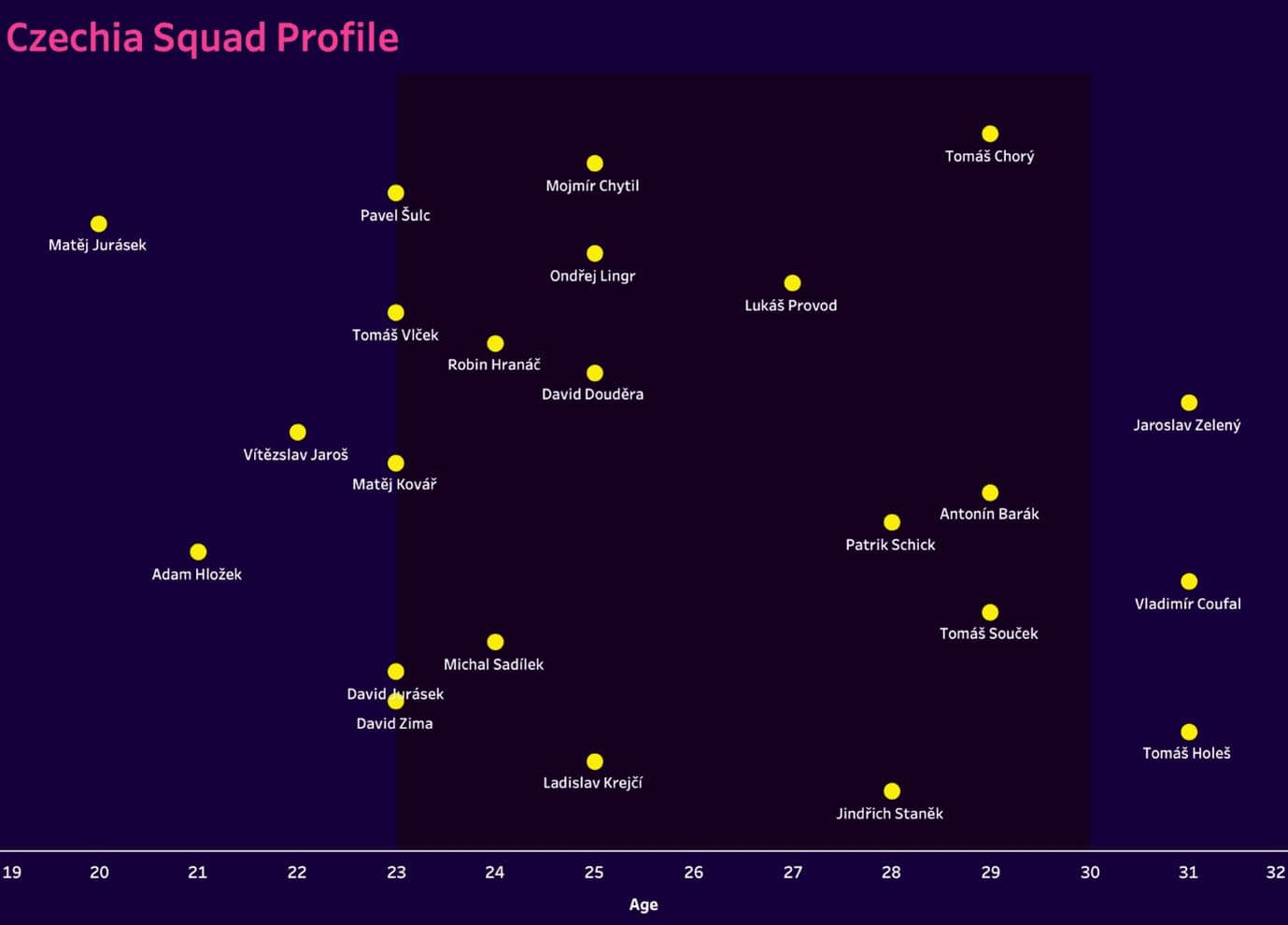
The squad’s average age is notably just 25.6, pointing towards a trend of youth and players approaching their peak.
Many experienced members of this squad, including Souček, Schick, and Barák, featured at Euro 2020 as well and will know what the Czech Republic will have to do to make it out of a tricky group.
This will likely be the strongest line-up they can put out should they select Coufal.
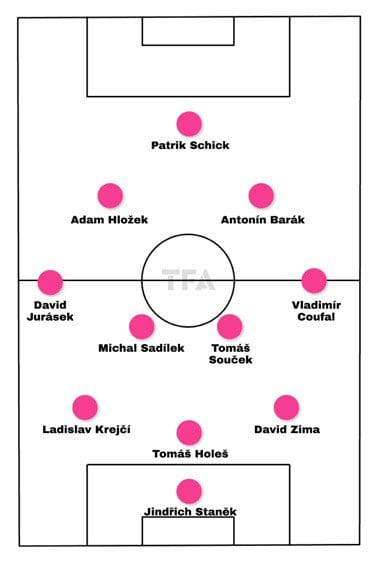
Attacking Phase
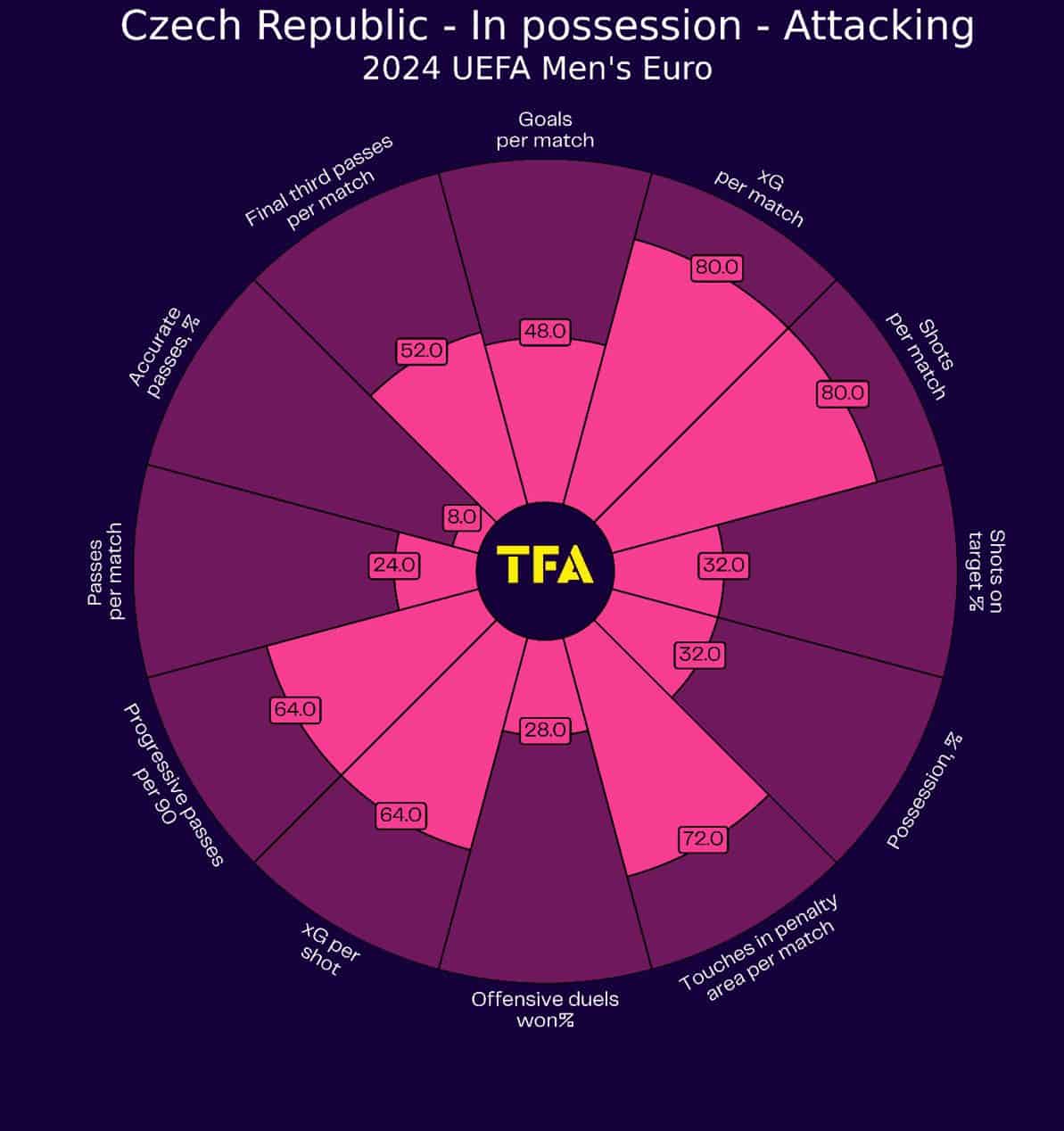
As the graph above shows, the Czech Republic are a high-volume shooting team but also take more touches in the penalty area, thus improving their expected goals (xG) per shot figure.
They are daring with their passes, which are fewer in number in comparison to most of their competitors, and content with limited possession, focusing on making every move with the ball count.
The Czech Republic’s build-up from the back under Hasek has seen them use a two-in system, wherein two of the three centre-backs stay deep while the third floats into midfield.
One or both of the holding midfielders drops back to help initiate play, with both wing-backs high and wide.
This allows the wingers the option to tuck in or also stay wide, depending on the opposition.
In the clip below from their match against Armenia, we see some of these elements in action, with the defenders marked in white, midfielders marked in black and attackers marked in blue.
We notice a box in midfield here, thanks to the attacking midfielder (Barák) dropping back from where The Czech Republic chose to progress the ball out wide.
However, if they wanted, they could also go to the midfield option and unsettle oppositions by switching the play.
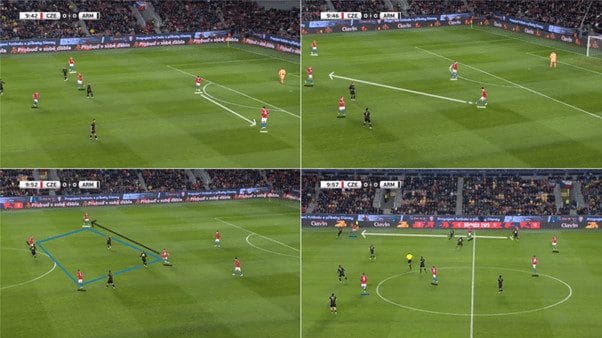
However, Hasek’s team also has versatility in their play.
In the second half of the same match, they shift to a back-four in possession after substituting their right wing-back, with the replacement dropping back.
The move beginning from the top-left clip below breaks down after a long ball, but they get a chance to reload with the same setup.
This time around, they get a numerical advantage as Armenia commits three men to the press, leaving the right wing-back plenty of room to race forward against a backtracking defence.
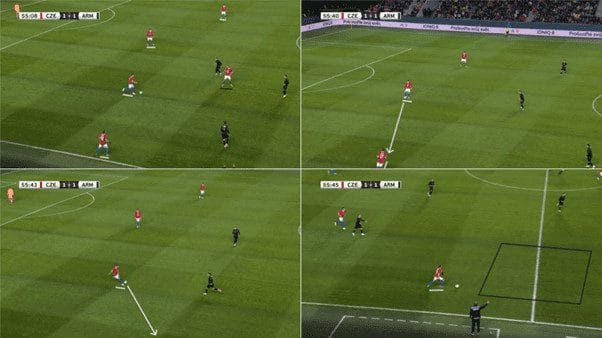
From here, the Czech Republic concentrate their attack on the right flank, with the left winger also tucking in, while the left wing-back stays high and wide for a possible switch.
The ball is then moved to the overlapping right wing-back by the centre-forward dropping back as the right-winger and left-winger make their way into the box, with the defenders distracted by the passing and movement in the centre.
The move ends with the cross reaching the far post, where the ball is cleared under pressure from the left wing-back.

Some of the Czech Republic’s passing and attacking metrics in the two matches under Hasek, albeit a small sample size, also suggest that they can attack teams in multiple ways.
Against Armenia, they had 60.55% possession, which dropped to 39.03% against Norway.
However, they took over 10 shots in both games, with over 40% on target (7/16 against Armenia and 5/11 against Norway).
Additionally, they were extremely accurate with their efforts from outside the box, getting five out of their seven such shots across both matches on target.
They also completed 12 of their 32 crosses (37.5% accuracy) and 63.75% of their long passes across the two games.
Hasek’s men didn’t enjoy much success from set-pieces or positional attacks, with only 9.09% and 29.69%, respectively, ending in a shot.
Defensive Phase
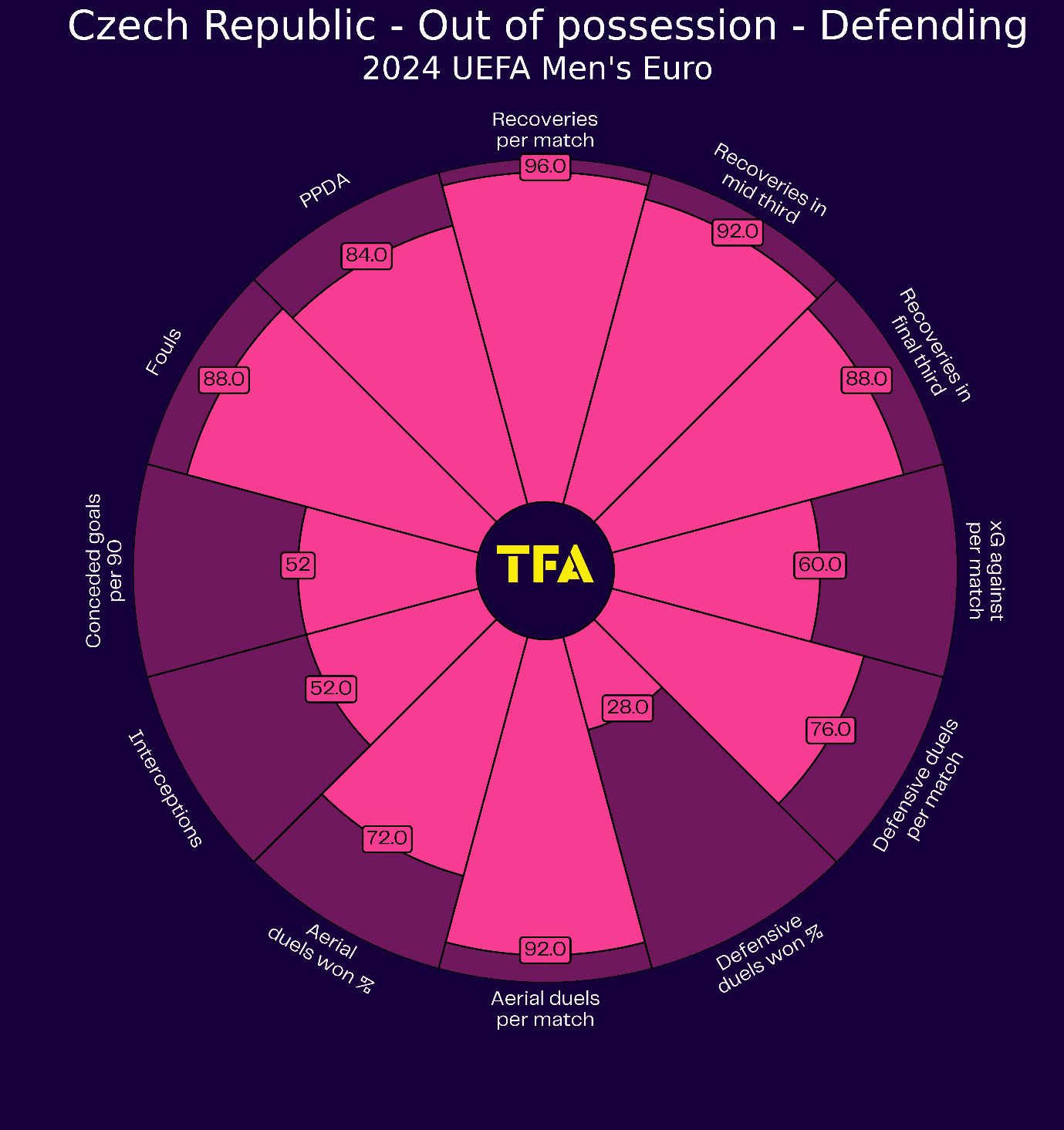
As evident from the chart above, the Czech Republic press their opponents well, ranking them high in the passes per defensive action (PPDA) and recoveries in the final third metrics.
Their xG against per match was also low for much of their qualifying campaign, while their duel success rate was high too.
All of these trends have been seen in Hasek’s first two matches in charge as well.
Their opponents created an xG of only 1.35 in those games, scoring twice, while the Czech Republic’s average PPDA was 8.68.
They had 173 recoveries to 186 losses and won 55.63% of their defensive duels, 38.33% of their offensive duels, and 41.31% of their aerial duels.
However, Hasek’s men are a foul-heavy team, giving away 25 fouls across two matches.
Their pressing from the top is not extremely high and can occasionally be picked apart by teams, as Armenia do below.
Here, a simple turn by the midfielder in the bottom-left panel allows him to release his partner, who is then able to spread the play out.
The move shifts from the original 5v4 to a 4v2 (both in Armenia’s favour).
Armenia go on to find their centre-forward, who drops back, with options in space on both flanks.
Luckily for the Czech Republic, the forward overhits the pass, and it’s eventually cleared out by a defender.
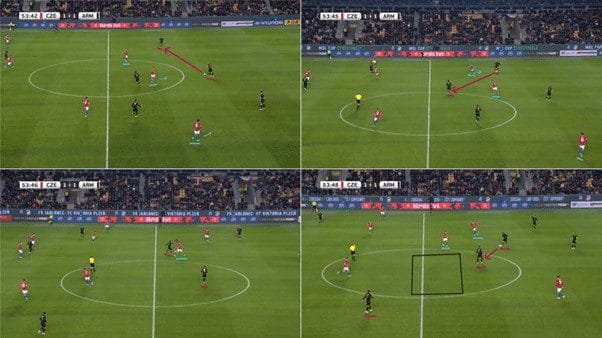
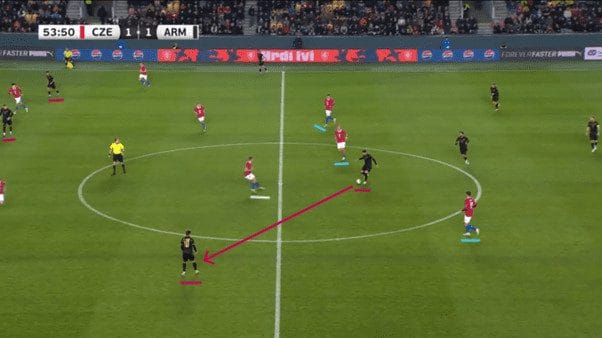
However, in the example against Norway, we see how their pressing triggers almost trap their opponents after the Norwegians win the ball high up the pitch but are forced back.
A foul following a sublime touch by Norwegian winger Oscar Bobb ends the move, highlighting both key features of the Czech Republic’s play (pressing and fouling).
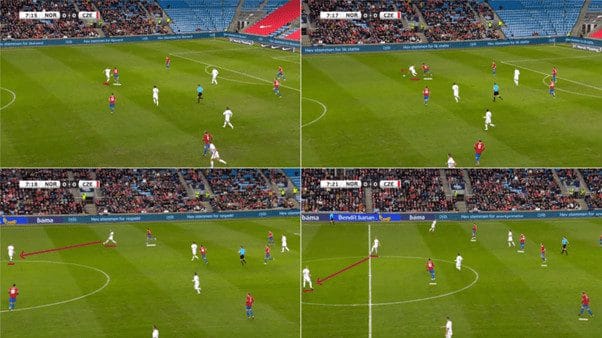
The Czech Republic’s pressing pattern becomes visible in the bottom-right panel.
Here, their centre-forward operates highest, while the two wingers and two holding midfielders form a four-man wall in midfield.
Norway, however, has one more player assisting in the build-up, but the Czechs counter this by using pressing triggers, as evident below.
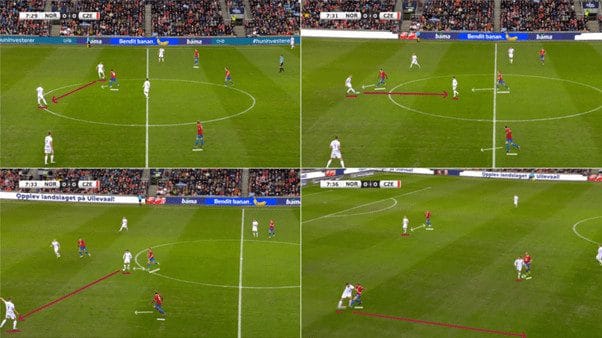
This is followed by Bobb’s excellent turn, which results in a foul.
While the organisation and pressing are excellent, this also exposes a fundamental weakness in the Czech Republic’s current defensive approach.
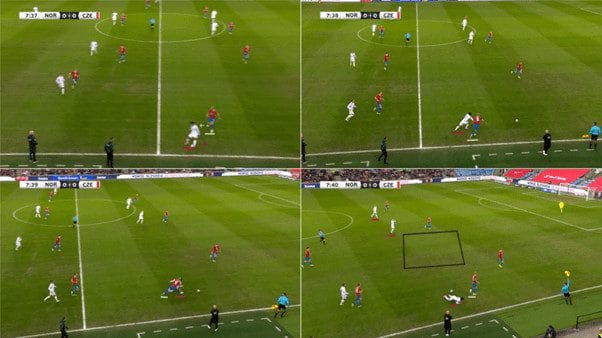
The foul is necessary in this scenario as we see the open spaces in between the Czech Republic’s midfield and defence, and if Bobb isn’t fouled, his teammate has acres to run into due to one of the centre-backs rushing in to help his teammate.
This is an area Hasek’s team need to work on, as these gaps arise both between midfield and attack, and midfield and defence.
However, this could also simply be a byproduct of the adaptation period and may improve with time spent on the coaching ground before this summer’s tournament.
It’s also worth noting that teams tend to play more conservatively in international tournaments and could struggle to find these gaps with ease.
Transitions
The Czech Republic are a dangerous side when they win the ball off their opponents, often countering at pace.
Under Hasek, three out of their five counterattacks across two games have ended in shots, with one even leading to the goal analysed below.
Hasek’s men break from a corner, establishing a 4v4 situation initially.
As the defenders track back, two more Czech players make their way forward, including their standard full-back overlap on the left, which Schick avoids before crossing to the other flank due to the lack of teammates in central areas in the box.
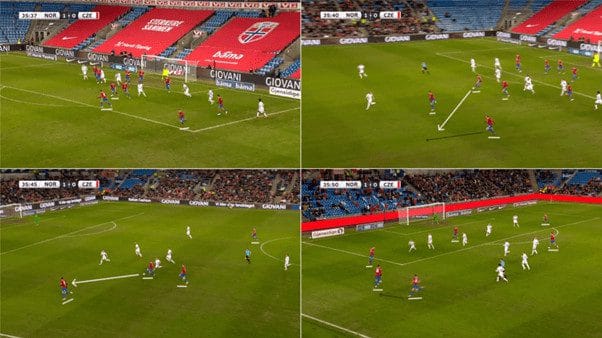
The cross is poor and reaches the other side of the box.
Souček reaches it, gets past a defender and then crosses it in for the goal.
Notice how the box at this point has six red shirts, all in and around the six-yard box to outnumber their opponents, with centre-back David Zima rising highest to head it home unchallenged after arriving late in the box.
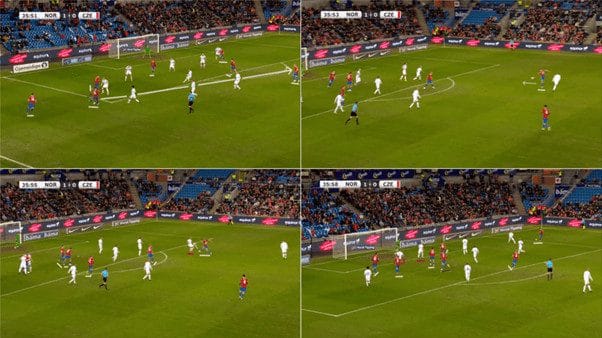
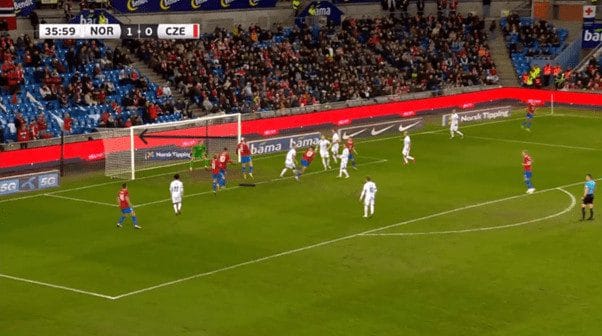
Two key things stand out in this possession.
The first is the Czech Republic’s willingness to pour men forward, with a central defender scoring the goal due to the license to rush forward, even at the expense of the backline being a little exposed.
We also see the full-backs make their way forward at pace to support the forwards, a regular occurrence for the team on counterattacks.
The Czechs thus prioritise countering from the flanks and overloading the box rather than moving centrally.
The second is the team’s commitment to the move even after a failed initial pass.
Most of the players stay forward despite needing Souček to get past a difficult 1v1 and position themselves extremely well, with runners to the near post and one player hanging back at the far post pulling the defenders in both directions.
This then frees up the area of maximum opportunity, i.e., the central zone right in front of the goalkeeper.
Forwards
The attackers in Hasek’s system have operated with freedom so far as the wide forwards have had the option of cutting infield.
At the same time, the centre-forward has occasionally dropped deep to become a 10, allowing one of the midfielders to get into the box.
Schick is likely to be one of the Czech Republic’s most important players at the Euros this summer.
The 28-year-old has enjoyed a stellar 2023/24 with domestic double winners Bayer Leverkusen after missing most of the first half of the season with adductor and calf injuries.
Since his return late last year, though, Schick has been excellent, scoring 13 times despite recording just 17 starts (30 appearances overall) for one of the best teams in Europe this term.
The centre-forward has been in the right positions at the right, receiving 7.30 progressive passes per 90 in the Bundesliga, which will be key to the Czechs’ chances at the Euros.
Schick’s 0.43 non-penalty xG ranks him in the 78th percentile among his peers in the German top flight, while he also scores with exactly half of his shots on target per 90.
While not the most adept dribbler, he averages 0.09 goal-creating actions through fouls drawn, which will also something to watch out for at the Euros.
Midfielders
As explained above, the Czech Republic’s midfield plays a crucial role in pressing while also assisting on the counter and with build-up.
As with most teams, the two holding midfielders in their predicted 3-4-3 will have plenty of offensive and defensive responsibility.
Souček is a guaranteed starter for the team and has already laid out an assist in two games under Hasek.
However, the x-factor could be Sadílek, who impressed for FC Twente this term with a goal and three assists in 30 matches.
The 23-year-old is one of the most adept passers in the Eredivisie this season, with an overall accuracy of 81.8% (on 65.64 attempts) and long-pass accuracy of 58.7% (9.77 attempts) while also providing 6.14 progressive passes and 5.56 passes into the final third (all per 90).
Sadílek is also an adept ball carrier, which could be crucial for the Czech Republic against teams who stay in a low block.
The Twente man averaged a progressive carrying distance of 88.59 yards (75th percentile) and was dispossessed only 0.38 times (92nd percentile) per 90.
He isn’t the most defensive-minded, but with Souček and the centre-backs for protection, he will likely be given some freedom offensively.
Defenders
Given their three-man backline, the Czech Republic’s centre-backs will be expected to assist build-up play by spreading themselves out across the pitch.
Their wing-backs, meanwhile, will have the license to fly forward and overlap the wingers, who alternate between staying wider and moving into more central positions.
Should Coufal return, he is likely to be key to the Czechs’ chances.
The 31-year-old, as mentioned earlier, averaging 0.12 expected assisted goals per 90, in addition to 1.12 passes and 0.62 crosses into the penalty area per 90, for West Ham in the Premier League this season.
He also reads danger well, averaging 1.24 interceptions and 2.81 clearances per 90.
Among defenders, Holeš is likely to be the most experienced member of the backline.
The Slavia Prague defender was particularly impressive in the UEFA Europa League this season, with his long passing (2.09 switches and 68.9% success on 11.91 long-ball attempts per 90 in the UEL) likely to add an extra layer to the Czech Republic’s build-up play.
He is also an adept tackler, particularly in midfield (1.29 tackles attempted in the middle third per 90), which will aid the Czechs’ transition offence.
Key Player
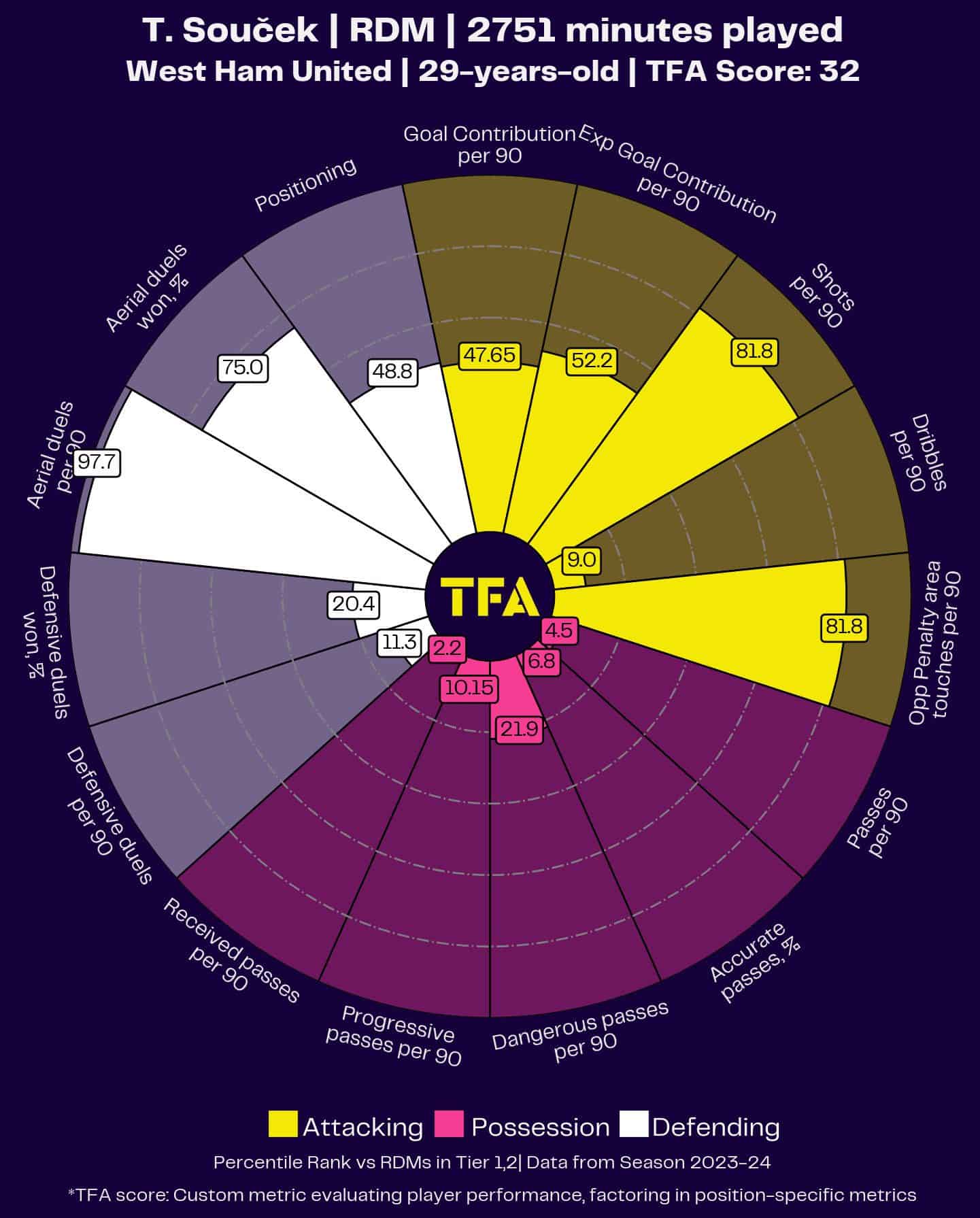
Souček is undoubtedly the most important player in the Czech Republic’s squad for the 2024 Euros.
He is the heartbeat of this team and is also likely to be the most experienced member of the squad with 68 caps (14th highest for his nation all-time) and 12 goals (joint eighth-most).
More recently, he enjoyed a solid campaign for a middling West Ham team, recording nine goals and three assists in 46 outings across the Premier League and Europa League.
In the top flight, his 0.22 non-penalty xG and 0.16 goals per shot both placed him in the 91st percentile among his peers.
Simultaneously, he was also an important defensive presence, as his heatmap shows.
Souček averaged 0.91 blocks per 90 minutes, along with 1.20 interceptions, 1.10 tackles won, and 3.40 clearances, while winning 58.2% of his aerial duels.
Much of the Czech Republic’s attacking forays at Euro 2024 will inevitably go through Souček, who will have to be at his very best if the team has to make a deep run.
Tournament prediction
Given the state of play in Group F, the Czech Republic will likely face difficulties in qualifying for the knockouts.
Portugal’s brilliant form under Roberto Martinez and obvious squad strength make them the favourites to top the group.
Turkey are likely to post a stiff challenge as well, having topped their qualification group, which had Croatia and Wales, with 17 points from eight matches.
However, we predict that the Czechs will sneak into the Round of 16 as one of the four best third-placed teams.
Should they manage that, they will take on the winner of Group B or C, potentially pitting them up against Spain, Croatia or England.
That stacks the odds against them, and while they could pull off a surprise in a one-off game, their campaign will likely end in the last 16.

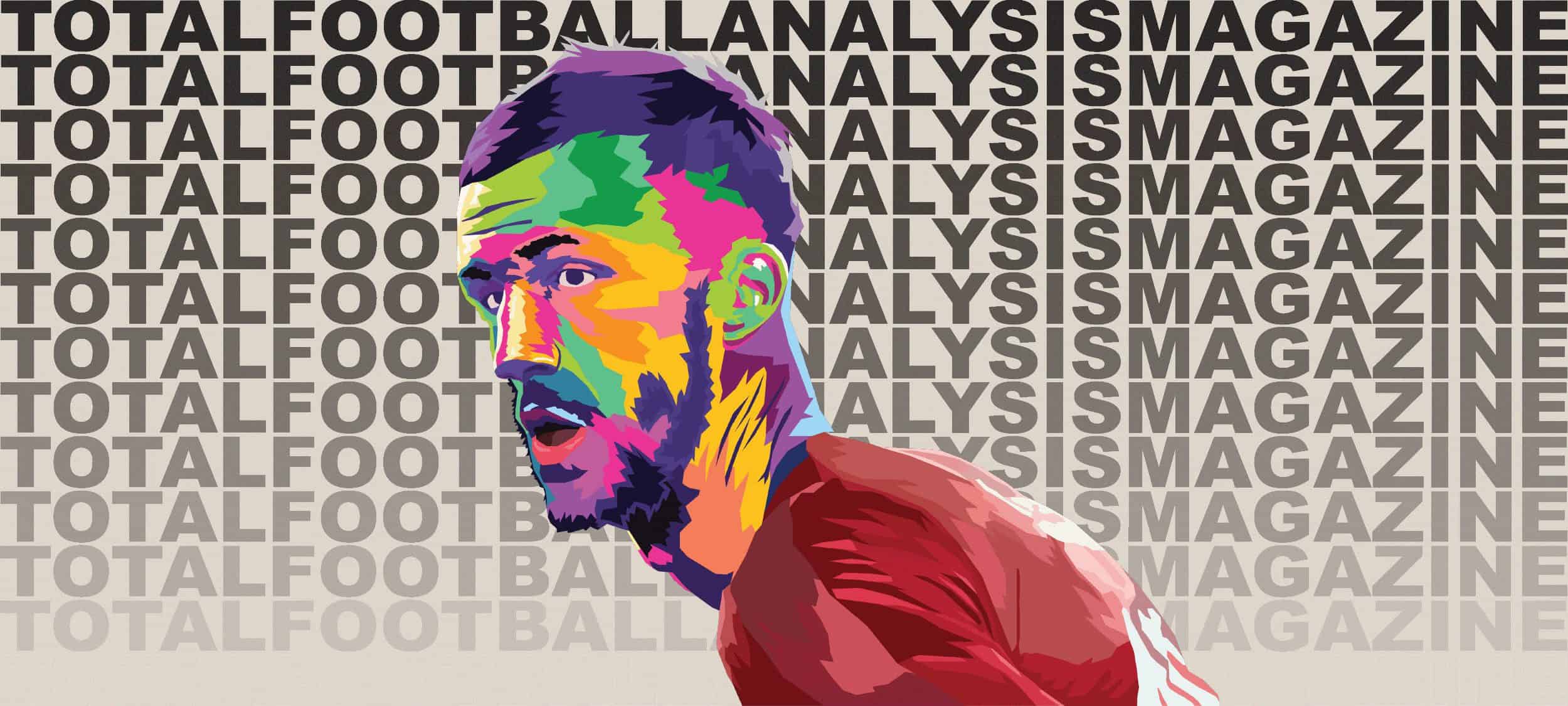



Comments